Iran Press/ Iran news: The general pattern of a Persian garden is a rectangular form consisting of four quarters abundant in trees and flowers, streams and pathways, ponds and fountains, usually a central pavilion, and the walls that surround the garden.
 A paradise in the arid desert; Shazde garden in Kerman province
A paradise in the arid desert; Shazde garden in Kerman province
The Persian gardens are so remarkable that nine gardens out of a wide variety are inscribed on UNESCO World Heritage Site. These gardens are located in different geographic parts of Iran with different climates and have their own unique features, but they are still similar in their overall structure.
Read More: Persian Caravanserai; What Iran is known for
Persian Paradise etymology
According to Persian literature, the word garden means “paradise “, which is derived from the word “paridaiza”. Paridaiza means a garden surrounded by walls. This walled garden creates harmony between nature and humans’ art of creation. The evergreen trees harness the sharp sunlight, the flowing water makes the environment cool, and the pavilion blocks the sunlight while providing a picturesque view from the terrace.
 Fin Garden in Kashan
Fin Garden in Kashan
Persian Garden through the ages
Persian garden holds roots in the 6th BC when Cyrus The Great who ruled over a vast territory, determined the plan of the ancient garden of Pasargadae and ordered it to be constructed at Pasargadae (close to Shiraz province). In fact, the unique plan of the Persian garden, its elaborate architecture, and the presence of natural elements originated from Cyrus’ notions. The purpose of the Persian garden was to provide physical and spiritual relaxation. So, it is true to say that it was during the Achaemenid Empire that the idea of an earthly paradise came into reality.
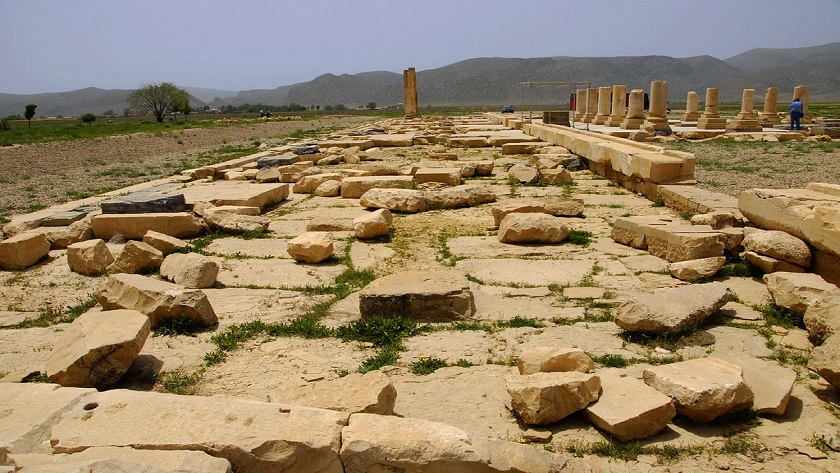 In ancient times there was a garden in Pasargadae
In ancient times there was a garden in Pasargadae
Later, the Sassanids created Persian gardens inspired by Zoroastrianism. According to their religious belief, the four quarters of the garden resembled four seasons of the year, and the importance of water running through the garden was more emphasized. The oldest documented illustration of Persian garden also dates back to the Sassanid era. In the bas-relief of Taq-e Bostan, the hunt-garden of Khosrow Parviz (the king of the Sassanid dynasty), is the oldest engraved work that depicts the geometry of the Persian garden.
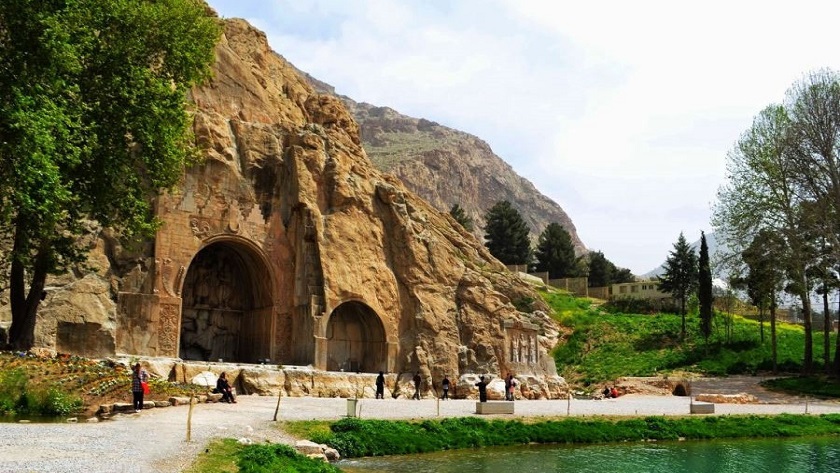 Taq-e Bostan dates back to Sassanid Period around 4th century AD
Taq-e Bostan dates back to Sassanid Period around 4th century AD
Persian Garden's significant properties
Persian Gardens are designed to represent the paradise that has been described in the Holy Qur’an. Natural elements, water streams, walls surrounding the gardens, summer houses or inside halls and chambers, and unique geometry art have given Persian gardens special characteristics that distinguish them from other gardens.
 Persian Garden resembles heaven on earth
Persian Garden resembles heaven on earth
While Persian Gardens can be found in different regions, their signature brilliance is better conceived in arid and hot regions of Iran, where water sources are scarce, sunlight and heat are plentiful and cool shades are a rare luxury; Hence, water, harnessing the light, lush vegetation are the principal elements of a Persian Garden.
 Water plays an important role in Persian garden design
Water plays an important role in Persian garden design
So Persian Gardens thrive on another genius invention of Iranians, qanats, underground water tunnels, channeling subterranean waters to the earth's surface to enable builders of the garden to use water for maintenance of the lush garden and its aesthetic design of it.
Read More: Persian Qanat; what Iran is known for
 A modern garden in Tehran inspired by old Persian garden style
A modern garden in Tehran inspired by old Persian garden style
Persian Garden Layout
Persian Garden is a walled long rectangular space, constructed on the gently sloping earth to allow the flow of water, and in the proper direction to best harness sunlight.
Man-made rills of water both circulate the garden and divide the garden in a cross-shape pattern. Tall trees line the circumference of the garden and each of 4 smaller sections provides shade during the day, while fruit trees and flowers are planted in the inner area.
Related news: Windcatcher; What Iran is Known for
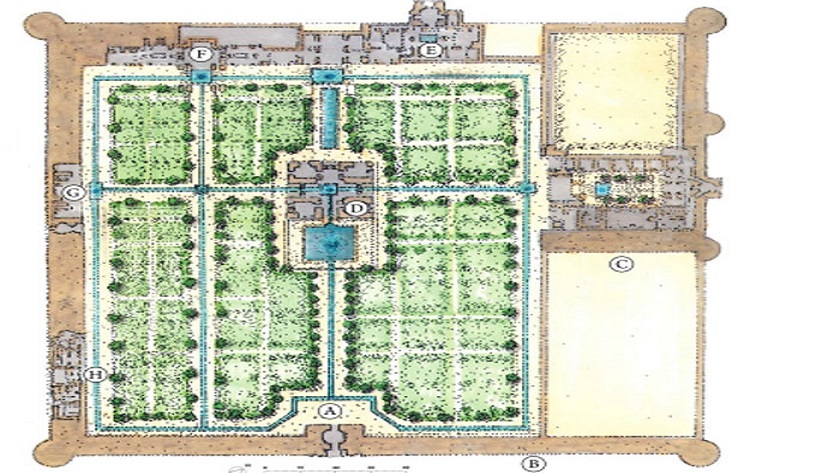 Fin Garden layout
Fin Garden layout
An Ornate Pavilion
The most common edifice in the garden is an ornate pavilion (a freestanding structure), located in the upper one-third section of the longitudinal axis to induce a sense of grandeur to the visitor who always enters the garden from the lower end through a grand portal entrance.
A lush pond is built in front of the pavilion. The pavilion is not at all enclosed but usually open on all 4 sides through arches to allow in the refreshing air, so masterfully created in the garden. A petite pond can be found in the pavilion as well.
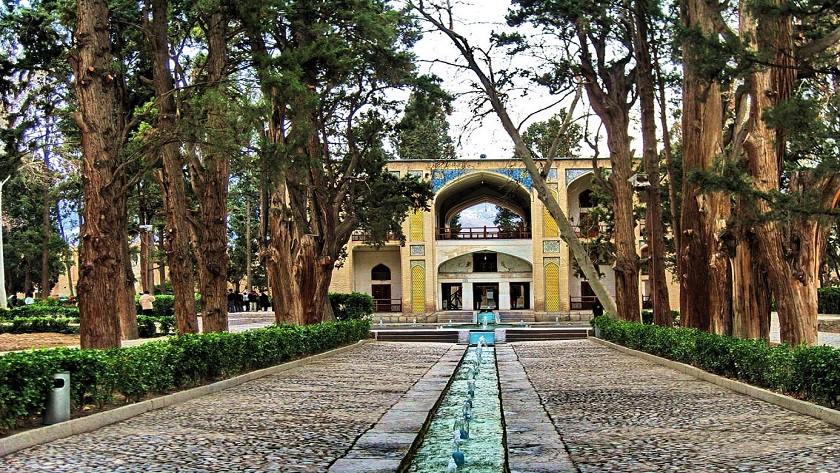 Pavilion of Fin Garden in Kashan
Pavilion of Fin Garden in Kashan
Persian Garden has also influenced other significant structures around the world. Taj Mahal in Agra, India, and Alhambra gardens in Spain are largely influenced by Persian Garden design.
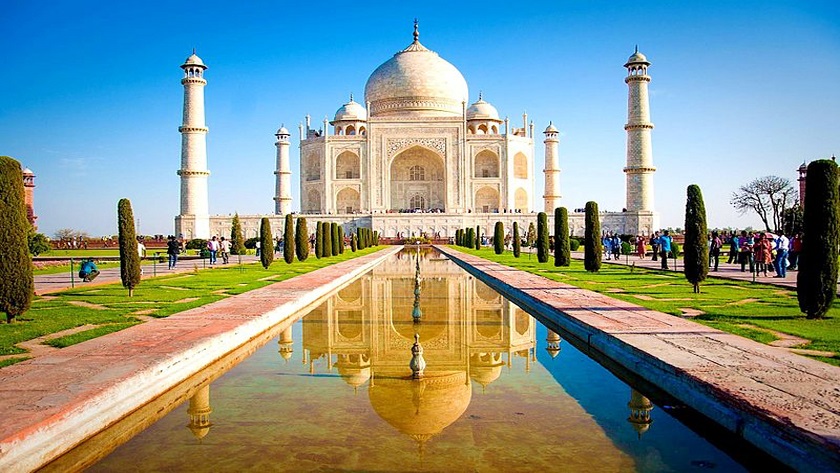 Taj Mahal in India is greatly inspired by the Persian Garden style
Taj Mahal in India is greatly inspired by the Persian Garden style
Fine Persian Gardens to visit
Persian Gardens are ready to host visitors with 13 of them registered on the UNESCO World Heritage Sites List. In the following list, some of the best Persian Gardens are introduced
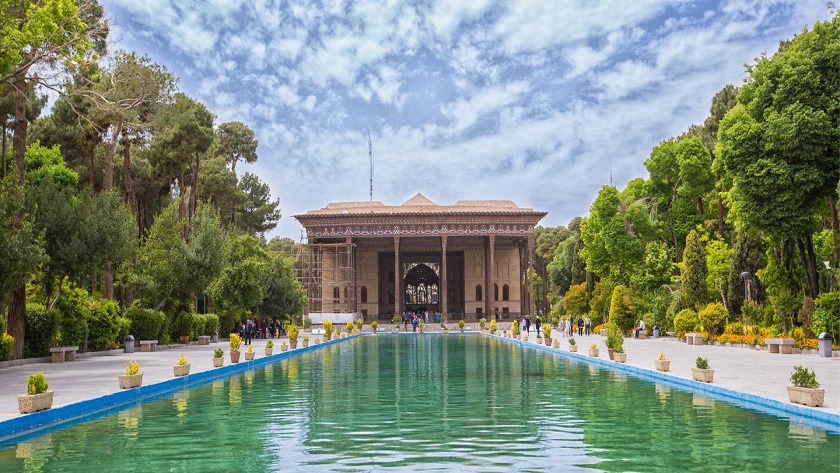 Chehel Sotun garden in Isfahan
Chehel Sotun garden in Isfahan
Chehel Sotun Garden in Isfahan
Chehel Sotun is one of the structures that remained from the Safavid era. “Chehel Sotun” literally means “40 columns”, which refers to the sum of its 20 columns and the reflection of those columns in the water pool in the middle of the courtyard. Chehel Sotun Garden was built by Shah Abbas II for entertainment and receptions. From the entrance, a large pool appears that extends to the end of the building. Visitors on both sides of the garden can enjoy the view of Pine, Elm, Plane (Platanus) trees, and also several Ailanthus altissima trees which are commonly known as Trees of Heaven. At the end of the walk, there is a pavilion that is built one meter above ground level.
 Chehel Sotun Palace is a masterpiece in Iranian architecture
Chehel Sotun Palace is a masterpiece in Iranian architecture
Fin Garden in Kashan
Fin Garden is one of the most visited attractions in Esfahan Province with common characteristics of Persian Garden architecture designed in almost any section. The design of Fin Garden strongly emphasizes water. The water is provided from the hillside behind it and is utilized without the need for pumping. The garden benefits from a complete piping system. Using clay pipes of different sizes and exact calculations of water pressure has made Fin Garden a true paradise in the middle of the dry land of Kashan.
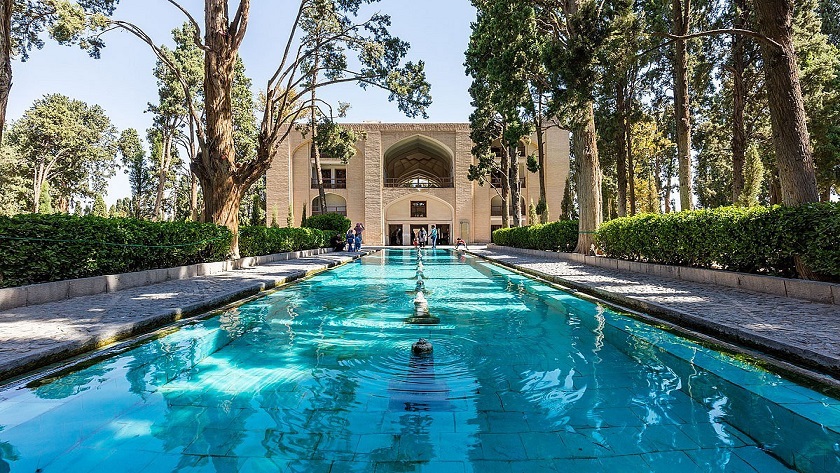 Fin Garden in Kashan utilizes a smart way of distributing water
Fin Garden in Kashan utilizes a smart way of distributing water
Kalat-e Naderi Garden
Kalat-e Naderi Garden is located in Kalat, Mashhad Province (north-east of Iran). Kalat-e Naderi Garden is a massive fortress with more than four miles (7.2 km) of circumference in the middle of the mountains. Kalat-e Naderi was built by Nader Shah Afshar, later became his keep. The place was residential long before Nader, but it came to be fortified when Nader Shah returned from India.
 Qasr-e Khorshid or Sun Palace in Kalat-e Naderi uses Iranian, Indian architecture
Qasr-e Khorshid or Sun Palace in Kalat-e Naderi uses Iranian, Indian architecture
Eram Garden
This Persian Garden in Shiraz was registered on UNESCO World Heritage Sites List in 2011. Eram Garden is one of the most spectacular Gardens in Iran located in Shiraz. The garden once belonged to the leader of the Qashqai tribe, but it has witnessed lots of restorations, modifications, and redesign. the structure is a three-storey building with 32 rooms. It is decorated with tiles, paintings related to Shahnameh, Qajar wars, and poems of Hafez (the prominent Iranian poet), and a lot of architectural features that are seen in Persian Gardens.
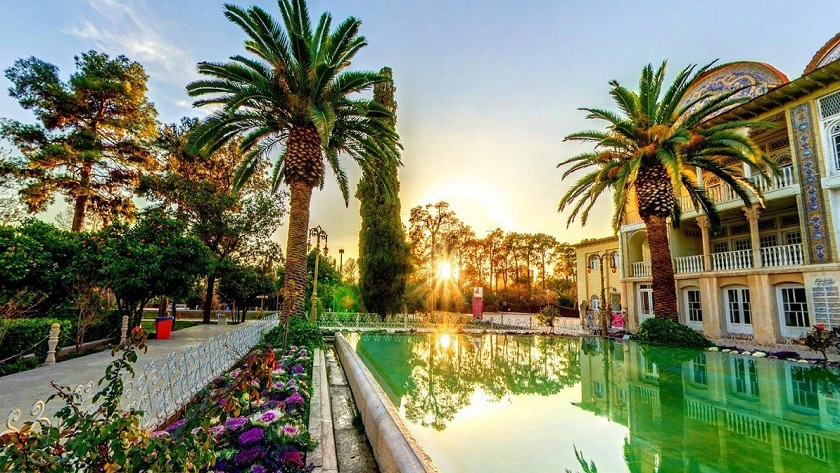 Eram Garden dates to Qajar era
Eram Garden dates to Qajar era
Persian Garden influence
Since Iranians appreciate art in different forms, the idea of the Persian garden has influenced the design, decoration, and description of other arts such as Persian carpets, pottery, calligraphy, music, and poetry. Among all, the Persian carpet is one of the best illustrations of the Persian garden. Many carpet designs are inspired by the Persian garden and it is better to say that the Persian carpet is a flat Persian garden with many trees, flowers, and birds.
 Shapouri Pavilion and Garden, an early 20th-century Persian garden in Shiraz
Shapouri Pavilion and Garden, an early 20th-century Persian garden in Shiraz
Though a very long time has passed since the construction of the Persian garden of Pasargadae in 6th BC, the Persian garden has kept its architectural and geometrical principles throughout history. It has also found its way to other countries, especially Agra in India and Andalusia in Spain. Moreover, Pasargadae Garden, Chehel Sotoun, Fin Garden, Eram Garden, Shazdeh Garden, Dowlatabad Garden, Abbasabad Garden, Akbarieh Garden, and Pahlevanpour Garden are the Persian gardens inscribed on UNESCO World Heritage Site, and they attract tours to Iran either by their survived plans or their scenic sceneries.
Read More:
Iran Dowlatabad Garden Photo Exhibition, preserves historical monument
UNESCO Culture Garden opens in Alborz of Iran
Ashkan Salehian

